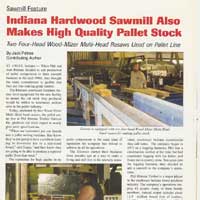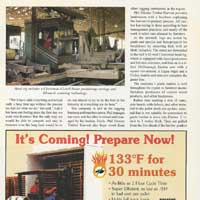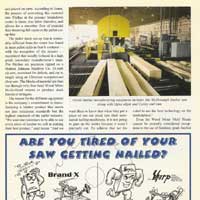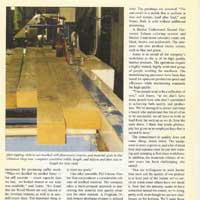Pallet Enterprise Article
Indiana Hardwood Sawmill Also Makes High Quality Pallet Stock. By Jack Petree
St. Croix, Indiana - When Phil and Joann decided to add production of pallet components to their sawmill business in the mid-1990's, they brought the same commitment to quality that they put into making grade lumber. The Etienne's purchased furniture factory level equipment for the the new facility to ensure the cut stock they produced would be milled to tolerances seldom seen in the pallet industry. Today anchored by two Wood Mizer Multi Head band resaws, the pallet cut-up line at Phil Etienne's Timber Harvest Inc. produces cut stock ripped to nearly glue joint specifications.
"When our customers put our boards into a pallet nailing machine, they know they are not going to have a problem leading to downtime due to a mis-sized board," said Joann, "and they know they are going to be able to produce a superior pallet from the stock." The reputaion for high quality in its pallet components is the same kind of reputation the company has strived to achieve in all its operations.
The Etiennes started their business three decades ago as a way to make a living and still live in the sparsely popluated, southwest Indiana countryside they call home. The company began in 1973 as a logging business; Phil was a construction worker at the time but had experience logging with his father, and Joann ran a country store. Ten years into the logging business, they decided to add a sawmill to the company's operations.
Phil Etienne Timber is a major player in the southwest Indiana forest products industry. The company's operations employ 63 people, many of them family members. Annual output includes about 12.5 million board feet of lumber, 11,600 tons of chips, 11,500 tons of fuel wood (sawdust, etc), 19,000 tons of bark for mulch, and 32,600 cubic yards of colored mulch. The company also sells a line of hand-carved wooden figures at craft fairs, gift shops and its offices in St. Croix.
The couple shares a "passion we have for their business" and a dedication to producing high quality lumber products that have fueled the company's success, said Joann. "We'd have sold everything and retired early a long time ago without the passion we feel for what we do," she said. "And it has been our feeling since the first day we went into business that the only way we would be able to compete and stay in business over the long haul would be to do our utmost to try to be the best in the industry at everything we do here."
The company is still in the logging business and runs two crews. Phil manages one crew and the other is owned and managed by his brother, Doyle. Phil Etienne Timber Harvest also buys wood from other logging contractors in the region. Phil Etienne Timber Harvest provides landowners with a brochure explaining the harvest-to-product process. All timber harvesting is done according to best management practices, and nearly all the work is select cuts planned by foresters.
At the sawmill, logs are sorted by grade and species and then prepared for breakdown by removing bark with the HMC debarker. The stems are forwarded to the mill's 42-inch Cleereman head rig, which is equipped with lineal positioners and Silvatec scanners, and then on to a 6 foot McDonough linebar saw with a square run-around. A Ligna edger and a Corley double-end rim saw complete the grade line. The company's grade lumber is sold throughout the region to furniture manufacturers, producers of custom wood products, and other businesses.
The company's grade lumber is sold throughout the region to furniture manufacturers, producers of custom wood products, and other business. Rather than sending a mix of cants, side boards with defects, and other material to the pallet stock cut-up line, material that is not suitable for conversion to grade lumber is sawn into flitches 2 1/2-inch to 3 inches thick. They are pulled from the line ahead of the lumber graders and placed on carts. According to Joann, the process of converting this material into flitches at the primary breakdown center is faster, less labor intensive, and allows for a smoother flow of material than resawing full cants on the pallet cut-up line.
The pallet stock cut-up line is noticeably different from the resaw line found in most pallet mills in that it contains - with the exception of the resaws - equipment that usually is found in a high grade secondary manufacturer's shop. The flitches are precision ripped on a Mereen Johnson Machine Co. 24-inch rip saw, examined for defects, and cut to length using an Ultimizer computerized chop saw. The blocks of material are then run through twin four-head Wood Mizer Multi-Head resaws to produce deck boards or stringer.
The reason for the different equipment is the company's commitment to manufacturing a lumber product that meets not just minimum standards but the highest standards of the pallet industry. "We want our customers to be able to use every piece of lumber we sell in making their best product," said Joann. "And we want them to know that when they put a piece of our cut stock into their automated nailing machinery, it is not going to gum up the works because it wasn't pricisely cut. To achieve that we decided to use the best technology on the marketplace." Even the Wood Mizer Multi Heads cannot be properly considered exceptions to the use of furniture grade lumber equipment for producting pallet stock. "When we decided we needed faster - but still accurate - resaw capacity than we had, we looked around to see what was available," said Joann. "We found that the Wood Mizers are well known in the furniture industry as well as in sawmill resaw lines. The important thing to us at the time was stepping up the speed while still ensuring a very accurate and smooth cut."
"The investment represented a big move for us, but we've been very happy with our decision. Acquiring the Wood Mizers was a step we had to take as a continuation of our focus on quality, and we've loved them. Wood Mizer has been a great company to work with, and the machines have allowed us to achieve the production levels we needed to maintain to meet our goals."
Like other sawmills, Phil Etienne Timber Harvest produces a considerable volume of risidual material. The company takes a multi-pronged approach to processing this material into quality products for other markets. A Fulghum 75 inch bottom discharge chipper is utilized to process clean wood into chips that are sold to pulp and paper plants.
Residue from the pallet stock cut-up operations is reduced through a Montgomery Hog and is used as the base for Etienne's Bear Hollow Mulch brand of colored landscaping mulch. A Bandit Beast horizontal grinder is used to process debarked slabs from other sawmills into additional material for colored mulch; the machine is fed by a chain and pinch mechanism with adjustable speed controls. The grindings are screened. "The end result is a mulch that is uniform in size and texture, load after load," said Joann. Bark is sold without additional processing.
A Becker Underwood Second Harvester Sahara coloring system and Becker Underwood colorants create red, black, grown, and gold mulch. The company can also produce exotic colors, such as blue and green.
Joann is as proud of the company's workforce as she is of its high quality lumber products. The operations require a highly trained, highly motivated group of people working the machines. The manufacturing process have been fine tuned for optimum production speed and efficiency while maintaining standards for high quality. "Your people tend to be a reflection of you," said Joann, "so we don't have many people here who aren't commited to achieving both quality and production. We've managed to attract and keep a bunch who understand that for all of us to be successful, we all have to work as hard from the neck up as we do from the neck down. I think that whole philosophy has given us an employee base that is second to none."
The commitment to quality does not come cheap, Joann noted. The equipment is more expensive, and a lot of extra time and expense must be put into training and retaining a first class workforce. In addition, the economic climate of recent years has been challenging, she added. "But our willingness to work harder than most and the quality of our product is at least part of the reason we've survived when some others have not made it. Now that the industry seems to have somewhat turned the corner, we're doing pretty well, even though we see new challenges on the horizon. We'll meet those head-on the same way we've met the challenges we've faced in the past."
No one visiting Phil Etienne Timber Harvest would call the operation ordinary. A passion for doing things ethically and well is evident in every facet of the company's activities. That passion for the business and desire to make a superior product have caused the company to prosper for three decades and positioned it to face the challenges of the future.



